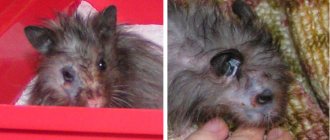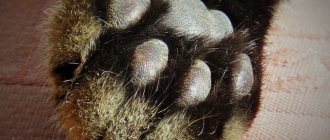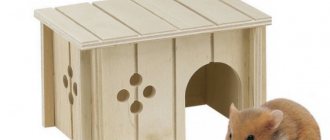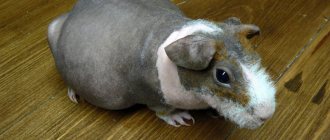Theoretical aspect of the issue
A chromosome is an important unit of the cell nucleus that carries genetic information. It is represented by a DNA molecule that forms complexes with histone proteins. Histones, in turn, contain large amounts of lysine and arginine. In a microscope, chromosomes are clearly visible during cell division, but in a non-dividing cell they are poorly visible - the DNA strands are too elongated and thin.
Cats have 19 pairs of chromosomes; with simple calculations, it can be determined that all their hereditary material is located on 38 chromosomes. For comparison, in humans this number is 46, that is, in 23 pairs.
Cats, like people, are multicellular organisms. A cell is a small structure of an organism, capable of self-reproduction, which includes components that interact with each other. These components are called organelles. Cat cells consist of the following organelles:
- Lysosomes are the smallest cellular organelles; they are presented in the form of vesicles, which contain enzymes that help them carry out their main function - the breakdown of fats, proteins and carbohydrates.
- The Golgi apparatus is a system of cavities in which the accumulation and distribution of incoming macromolecules throughout the cell occurs. The Golgi apparatus is also involved in the formation of lysosomes.
- Centrioles - located in the cell center, are cylinders of microtubules. It is the microtubules that determine the shape and geometry of the cell and orient the organelles as they move.
- Plasma membrane – separates cells from neighboring elements.
- Cytoskeletal fibers are formed by filament proteins that form the musculoskeletal system of the cell and structure it. It is thanks to filaments that cells can change their shape and the relative position of organelles.
- Mitochondria are the source of energy of the cell. They can be in the shape of a ball, thread or stick. Inside it, the process of converting the energy of nutrients entering the cell into ATP energy occurs.
- The endoplasmic reticulum is a system that consists of tubules and cavities that have different shapes and sizes. This organelle performs the functions of movement and metabolism within cells, and is also the place where the ribosome that has left the nucleus is attached.
- Ribosomes are small non-membrane organelles on the surface of which protein synthesis occurs.
- The nucleus is the largest organelle present in the cell. This is where the genetic information about the body is located, enclosed in the DNA molecule.
- The nucleolus is a round body that is located directly in the nucleus. It is the site of ribosome assembly.
It is important to understand that what characteristics the future offspring will receive depends not at all on the number of genes, but on the order and sequence of arrangement of the huge number of amino acids included in the gene. There are about 20 thousand genes in cat DNA; they consist of four amino acids, which are collected in groups of three. These groups subsequently form a 64-letter alphabet, in which one letter represents the beginning of one gene. It, in turn, carries information about any individual property of the organism.
Pathways of cell division in cats:
- Mitosis - the cell divides after it has accumulated a sufficient amount of amino acids. In this case, the chromosomes reproduce themselves, doubling, where the daughter cells are an exact copy of their parents. In this case, genes have 2 or more levels of manifestation - dominant and recessive. Somatic cells divide by mitosis.
- Meiosis - in which in cats, each parent needs to pass on genes from only one chromosome included in this pair. Unlike mitosis, during meiosis the number of chromosomes decreases by 2 times. At the moment of union of the egg with the sperm, carrying half the number of chromosomes - one of each pair - a complete set is formed - 19 pairs. Sex cells divide by meiosis.
Somatic and germ cells differ from each other in that germ cells give rise to the next generation of gametes, and somatic cells do not take part in the process of sexual reproduction, and therefore do not leave offspring. There is a version that the role of somatic cells is to maintain the reproduction and survival of germ cells.
The karyotype—the set of genes—possessed by modern cats was derived from their immediate genetic ancestor, the African Wildcat. Its genes are part of the main set in cats of all breeds.
Chromosome set of a domestic cat
A mutation is a partial change in the genetic code. Causes of mutations:
- Incomplete division of DNA molecules during meiosis;
- Incomplete division of DNA molecules during mitosis;
- Exposure to the division of any mutagen, for example, nicotine or radiation.
Pieces of cat heredity
The science of genetics studies heredity and the number of chromosomes. The number and structure of particles of heredity for each species of animal is a constant parameter and it is called a karyotype. Any deviations can provoke hereditary diseases, the appearance of inactive individuals or new species. All pairs of chromosomes, and a cat has 19 of them, are identical in shape and appearance . The exception is one pair responsible for sexual characteristics - it has particles of heredity of different sizes: the X chromosome that determines the female sex is larger, and the male sex, Y, has a smaller size. The sex of the future individual depends on their combination during fertilization.
The information embedded in DNA is called the genotype, and the external expression of the characteristics is called the phenotype. All genes are paired - one from each cat. One of them is dominant, stronger and determines the manifestation of its characteristics in kittens. The other is recessive, it is oppressed by the dominant and is hidden until required. And when two recessive ones come together - from a cat and a female cat, the result is kittens that are not similar to either one or the other. For example, a white cat and a black cat may produce red offspring if both recessive genes are responsible for the red color. Feline heritable traits are as follows:
- dimensions and contour of the auricle, location of the ears;
- coat color and hair length;
- eye pigmentation;
- tail length and others.
Culling of defective individuals is carried out in order to maintain the purity of the breed based on the analysis of the chromosome set. It is important to keep a record of deviations of noticed disorders in order to try to influence the correction of anomalies through rational feeding and training of cats. In this way, it is possible to uncover suppressed genes that can influence the improvement of the breed or give impetus to the creation of a new one.
Features of the karyotype of some breeds
There are groups of genes that have been studied by science. Their location and properties are known.
According to their effect on the body, they are divided into:
- Body shape genes;
- Genes for coat length and texture;
- Coat pattern and color.
Color genes are also divided into 3 groups:
- Color genes – genes responsible for the density and shade of fur;
- Pattern genes - color brightness and pattern;
- Genes responsible for masks that can appear in a cat's color.
Body shape genes - form important external characteristics, such as paws, ears, tail. Below are some of them:
- Normal Ears/Scottish Fold Ears;
- Extra Toes/Regular Paws;
- Manx – no tail at all/Broken tail/Regular tail.
Coat genes are responsible for the texture and length of the coat:
- Sphinx genes - a recessive mutation leads to the hairlessness of sphinxes, while the normal allele dominates and forms normal hair in cats.
- Genes for long hair - formed as a result of a recessive mutation, which made it possible to obtain breeds such as Siberian, Angora, Persian.
Genes for color or coat color have three subgroups:
- Genes for black coat color have a total of 3 alleles, but in addition to them they also have an allele for albinism.
- The genes for red color have 2 alleles: color and complete absence of orange.
In this article, we examined the main points and concepts of cat genetics, mainly related to appearance. The main thing to remember is that everything is not as simple as it seems at first glance; you can delve into these issues and study the little things endlessly!
Principles of cat heredity
The information contained in chromosomes is the genotype. In turn, the external manifestations of certain characteristics are called phenotype.
Genes are arranged in pairs (one each from the mother and father) - alleles and are distinguished into the following subtypes:
- Dominant, that is, predominant. Thanks to this gene, certain characteristics of appearance are inherited by the offspring of the first generation.
- Recessive. Being a suppressed dominant, hidden for some time. Recessive genes combined with each other produce offspring that are unlike their parents.
Let's look at inherited traits:
- color;
- eye color;
- wool structure;
- size, shape and position of the ears;
- tail length and thickness;
- structure of the body and limbs.
Chromosomes: structure, functions. Number of chromosomes
Unified State Examination section: 2.7. A cell is the genetic unit of a living thing. Chromosomes, their structure (shape and size) and functions. The number of chromosomes and their species constancy. Somatic and germ cells. Cell life cycle: interphase and mitosis. Mitosis is the division of somatic cells. Meiosis. Phases of mitosis and meiosis. Development of germ cells in plants and animals. Cell division is the basis for the growth, development and reproduction of organisms. The role of meiosis and mitosis
A cell is the genetic unit of a living thing.
A cell is a structural and functional elementary unit of the structure and life activity of all organisms (except for viruses and viroids - life forms that do not have a cellular structure). It has its own metabolism and is capable of self-reproduction.
The contents of the cell are separated from the environment by the plasma membrane. Inside the cell is filled with cytoplasm, in which various organelles and cellular inclusions are located, as well as genetic material in the form of a DNA molecule. Each of the cell organelles performs its own special function, and together they all determine the vital activity of the cell as a whole.
Deoxyribonucleic acid (DNA) is a macromolecule (one of the three main ones, the other two are RNA and proteins) that ensures storage, transmission from generation to generation and implementation of the genetic program for the development and functioning of living organisms. The DNA molecule stores biological information in the form of a genetic code consisting of a sequence of nucleotides. DNA contains information about the structure of various types of RNA and proteins.
Chromosomes
Chromosomes are nucleoprotein structures of the cell in which most of the hereditary information is concentrated and which are intended for its storage, implementation and transmission. Chromosomes are clearly visible in a light microscope only during mitosis or meiosis. The set of all the chromosomes of a cell, called a karyotype.
A chromosome is formed from a single and extremely long DNA molecule that contains a group of many genes. A complex of proteins bound to DNA forms chromatin. Chromatin is a nucleoprotein that forms the basis of chromosomes, located inside the nucleus of eukaryotic cells and is part of the nucleoid in prokaryotes. It is in the composition of chromatin that genetic information is realized, as well as DNA replication and repair.
The structure of the chromosome is best seen in metaphase of mitosis. It is a rod-shaped structure and consists of two sister chromatids held by the centromere in the region of the primary constriction.
Under a microscope, it can be seen that the chromosomes have transverse stripes, which alternate in different chromosomes in different ways. Pairs of chromosomes are recognized, taking into account the distribution of light and dark stripes (alternating AT and GC pairs). Chromosomes of representatives of different species have transverse striations. Related species, such as humans and chimpanzees, have a similar pattern of alternating bands in their chromosomes.
Any organism has a lot of genes encoding various traits. So, according to rough estimates, a person has about 120 thousand genes, and there are only 23 types of chromosomes. All this huge number of genes are located on these chromosomes.
Number of chromosomes and their species constancy
Each species of plant and animal normally has a strictly defined and constant number of chromosomes, which can vary in size and shape. Therefore, we can say that the number of chromosomes and their morphological features are a characteristic feature for a given species. This feature is known as species constancy of chromosome number.
The number of chromosomes in one cell in different species: gorilla - 48, macaque - 42, cat - 38, dog - 78, cow - 120, hedgehog -96, pea - 14, birch - 84, onion - 16, wheat - 42. The smallest the number in an ant is 2, the largest in one of the fern species is 1260 chromosomes per cell.
There are 46 chromosomes in the human karyotype - 22 pairs of autosomes and one pair of sex chromosomes. Males are heterogametic (XY sex chromosomes) and females are homogametic (XX sex chromosomes). The Y chromosome differs from the X chromosome by the absence of some alleles. For example, there is no blood clotting allele on the Y chromosome. As a result, hemophilia usually only affects boys.
Chromosomes of the same pair are called homologous. Homologous chromosomes in identical loci (locations) carry allelic genes (genes responsible for one trait).
Chromosomal theory of heredity
The chromosomal theory of heredity was created by the outstanding American geneticist Thomas Morgan (1866-1945):
- a gene is a section of a chromosome. Chromosomes thus represent linkage groups of genes.
- allelic genes are located in strictly defined places (loci) of homologous chromosomes.
- genes are located linearly on chromosomes, that is, one after another.
- During the formation of gametes, conjugation occurs between homologous chromosomes, as a result of which they can exchange allelic genes, i.e. crossing over may occur. Genes on the same chromosome are not inherited linked.
The phenomenon of crossing over helped scientists establish the location of each gene on a chromosome and create genetic maps of chromosomes (chromosomal maps). The probability of two genes diverging on different chromosomes during crossing over depends on the distance between them in the chromosome.
To date, using crossover counting and other, more modern methods, genetic maps of the chromosomes of many species of living beings have been constructed; peas, tomatoes, fruit flies, mice. In addition, work continues successfully to compile genetic maps of human chromosomes, which can help in the fight against various currently incurable diseases.
Substances that cause genetic mutations
It will be useful for owners of domestic cats to remember about substances that can cause mutations in the animal's genes and, as a result, its infertility and fatal diseases. They also affect the fetus of a pregnant cat and can lead to congenital deformities or miscarriage. These substances (and the medications that contain them) include:
- chemicals (lead, mercury, 2,4,5-T(trimethylbenzene));
- carbaryl;
- chlorpromazine;
- cyclophosphamide;
- cytosine arabinoside;
- dichlorvoz;
- erythromycin;
- griseofulmicin;
- halothane;
- phenobarbital;
- phenylbutazone;
- primidone;
- streptomycin;
- theophylline;
- vincristine;
- Some medications used in feline veterinary medicine, for example:
- all tranquilizers (Elenium, Sibazon, Tazepam, Mazepam, etc.).
It is necessary to protect the cat from contact with these substances, and use the medications mentioned only if it is a question of saving the cat’s life, and there is no other treatment.
Chromosomes are where genetic information is stored - a compressed DNA molecule containing thousands of genes. They are responsible for the structure of the body and its external manifestations. If the chromosomes are broken or the number of chromosomes is incorrect, illnesses, developmental problems in the cat, or distinctive appearance characteristics may occur.
Genetics is the science that explains the birth of animals with different colors and coat types. In particular, it was she who “told” people how many chromosomes a cat has and what the characteristics of the karyotype are.
We invite you to familiarize yourself with Feline Immunodeficiency Virus (FIV)
How many chromosomes does a tiger have?
The tiger is a big and beautiful cat. The species is exclusively Asian and was once found everywhere: from Turkey and Iran to India and Siberia. Accordingly, it had many subspecies, most of which, alas, have become extinct by modern times.
There are few modern tigers - four to six thousand individuals, and most of them are Bengal tigers. Unfortunately, the problem is not only the low number of these cats in general, but also their rather fragmented range, and therefore individual subspecies are practically isolated from each other.
All the splendor of this wonderful beast is “recorded” in genes stored on exactly 19 pairs of chromosomes. In other words, a tiger has 38 chromosomes.
Interestingly, not only the tiger has 38 chromosomes, but also the lion, leopard, cheetah, jaguar and even the domestic cat! A possible reason for this is the relative youth of the species: it is believed to have separated from a common ancestor about two million years ago, slightly earlier than lions and jagurs. So it is not surprising that tigers have viable hybrids with these species.
Tiger (Panthera tigris Linnaeus, 1758), a species of the genus Panthera. The cat is very large in size: body weight of males up to 320 kg, females up to 180 kg, body length of males up to 290 cm, females up to 190-200 cm, tail length of males 115 cm, females up to 110 cm. There are “whiskers” on the cheeks.
The fur color is reddish-red or reddish-yellow with contrasting transverse narrow stripes. It differs from other large cats in color and pattern. There are 38 chromosomes in the karyotype.
Tiger
The geographical variability of the tiger's color, body size and fur type is great; about 6-8 subspecies are recognized as real, in Russia - 2, of which one (Turanian tiger) has been exterminated.
The tiger is widespread in the forests and reed beds of South, South-East, Middle, and certain regions of Western and Central Asia. In Russia it lives in the Far East. Inhabits biotopes with dense tree and shrub vegetation - tropical forests, mangroves, coniferous mountain forests, tugai, rises to mountains up to 2500-3000 m above sea level. In the Far East, it lives in low mountains, in river valleys, and in paddocks overgrown with Manchurian-type vegetation with a predominance of cedar and oak. The basis of nutrition is large ungulates (wild pigs, deer, bulls, antelopes). The tiger can attack livestock. There are known cases of cannibalism. Swims well. It lives alone, the female lives with her brood. During the rut, one female can be followed by 2 to 6 males. The area of an individual tiger's territory is 300-400 km2. Scent marks, as well as acoustic and visual signals, are of great importance in tiger communication.
Tiger breeding is not confined to any specific season; females participate in it once every 2-3 years. Estrus in females occurs at any time of the year and in uncovered tigresses repeats after 2-3 months. The birth of young usually occurs in spring or late autumn. Pregnancy is 95-107 days, with an average of 103 days. There are usually 2-4 tiger cubs in a litter, rarely 5-6. Tiger kittens (weighing from 785 to 1043 g) are born blind, with closed ear canals. They begin to see the light at 6-8 days, the ear canals open at 4-5. They grow and develop quickly. They stay with the female for 2-3 years, and in the fourth year they move on to independent life. Sexual maturity is reached at the age of 3 years 4 months - 3 years 8 months. Rare view. There is a special international program for tiger conservation in Russia.
The fur color is reddish-red or reddish-yellow with contrasting transverse narrow stripes. It differs from other large cats in color and pattern. There are 38 chromosomes in the karyotype.
Tiger
The geographical variability of the tiger's color, body size and fur type is great; about 6-8 subspecies are recognized as real, in Russia - 2, of which one (Turanian tiger) has been exterminated.
The tiger is widespread in the forests and reed beds of South, South-East, Middle, and certain regions of Western and Central Asia. In Russia it lives in the Far East. Inhabits biotopes with dense tree and shrub vegetation - tropical forests, mangroves, coniferous mountain forests, tugai, rises to mountains up to 2500-3000 m above sea level. In the Far East, it lives in low mountains, in river valleys, and in paddocks overgrown with Manchurian-type vegetation with a predominance of cedar and oak. The basis of nutrition is large ungulates (wild pigs, deer, bulls, antelopes). The tiger can attack livestock. There are known cases of cannibalism. Swims well. It lives alone, the female lives with her brood. During the rut, one female can be followed by 2 to 6 males. The area of an individual tiger's territory is 300-400 km2. Scent marks, as well as acoustic and visual signals, are of great importance in tiger communication.
Tiger breeding is not confined to any specific season; females participate in it once every 2-3 years. Estrus in females occurs at any time of the year and in uncovered tigresses repeats after 2-3 months. The birth of young usually occurs in spring or late autumn. Pregnancy is 95-107 days, with an average of 103 days. There are usually 2-4 tiger cubs in a litter, rarely 5-6. Tiger kittens (weighing from 785 to 1043 g) are born blind, with closed ear canals. They begin to see the light at 6-8 days, the ear canals open at 4-5. They grow and develop quickly. They stay with the female for 2-3 years, and in the fourth year they move on to independent life. Sexual maturity is reached at the age of 3 years 4 months - 3 years 8 months. Rare view. There is a special international program for tiger conservation in Russia.
History of the term
L. N. Delaunay proposed the term “karyotype” in his work “Comparative karyological study of Muscari Mill species. and Bellevalia Lapeyr", the article was published in 1922 in the "Bulletin of the Tiflis Botanical Garden"[1][2]. L. N. Delaunay defined a karyotype as a set of chromosomes, determined by their number, size and shape [3]. L.N.
Delaunay suggested that all species of the genus have the same set of chromosomes (“karyotype”); different genera, according to Delaunay, necessarily differ karyotypically[4]. G. A. Levitsky, based on his own research, showed that this is not true, and in his book “Material Bases of Heredity” he developed and clarified the term “karyotype” [5] [6]. Cyril Dean Darlington and Michael J.D. White also contributed to the development of the term.










